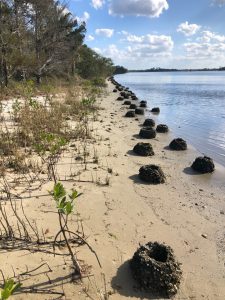
A living shoreline uses natural materials such as marsh grasses, mangroves, and bags of oyster shell to stabilize the shoreline. Living shorelines prevent erosion while simultaneously restoring habitat. Residents living in coastal areas affected by erosion due to boat wakes, storms, or a loss of natural habitat may consider a living shoreline for their property.
This blog provides answers to some of the most frequently asked questions about living shorelines in Volusia and Flagler Counties. Most of the information pertains statewide in Florida, and you can find resources to appropriate plants in your area, examples of local living shorelines, and contacts in your region at the Florida Living Shorelines website.
What is a living shoreline?
Living shorelines use natural species and processes to stabilize the shoreline and prevent erosion. Living shorelines can help protect property along the coasts as well as provide many ecosystem services, including creating habitat, promoting, biodiversity, and sequestering carbon. Living shorelines use appropriate plant species – in our area that is usually smooth cordgrass (Spartina alterniflora) and red, black, or white mangroves. They may also include bags or gabions of oyster shells to serve as a breakwater.
Why would I want a living shoreline?
If you live along a coastal shoreline, such as the intracoastal waterway or a tributary, you may experience erosion of land into the waterway. Living shorelines are an alternative to the traditional “hard stabilization” that has typically taken place along shorelines in the form of seawalls. While both seawalls and living shorelines reduce shoreline erosion, living shorelines have some advantages. These include:
- Protects, restores, and enhances wildlife habitats
- Improves water quality
- Absorbs wave energy and storm surge
- Becomes more stable over time and can adapt to sea level rise
- Provides a natural aesthetic
Whether a living shoreline is the proper way to protect your shoreline depends on many factors, such as the slope of the shore and level of wave action.
Do I need a permit to create a living shoreline on my property?
Yes. Any work that is done below the Mean High Water (MHW) line requires a permit from the Florida Department of Environmental Protection (DEP) and the US Army Corps of Engineers (ACOE). However, most residential living shorelines projects fit the “exemption category.” Paperwork still needs to be submitted and approved for exempt projects, but these categories have minimal requirements and no fees.
You can find information about permitting for living shorelines on the Florida Living Shorelines Permitting page. In addition, you can find step-by-step instructions for completing the permitting processes for both the Florida DEP and US Army Corps of Engineers though the links. Before you begin the permitting process, reach out to your local DEP or ACOE offices to set up a pre-application meeting review the process.

I have seen bags of oyster shells being used as shoreline protection. Can I get these and put them along my shoreline?
Yes, you are able to obtain oyster shell gabions from several providers in our area, including Marine Discovery Center and Gamble Rogers State Park, but you will need to apply for permits before you are able to utilize these on your property below the Mean High Water line. To qualify for a living shoreline exemption in the permitting process, you will need to incorporate vegetation into your living shoreline in addition to the bags of oyster shells.

Where can I see an example of a living shoreline?
The Marine Discovery Center in New Smyrna Beach has an educational and functional display of shorelines, ranging from traditional “gray” shorelines with seawalls and rip rap to living shorelines with marsh and mangroves. This site is open to the public.
You can also arrange a site visit to the living shorelines installed at Riverside Conservancy in Edgewater.
In Flagler County, you can visit Gamble Rogers State Park and Washington Oaks Gardens State Park to see two living shoreline projects that were installed in spring 2022.
I want to have a living shoreline on my property, but I do not want to do it myself. Can someone else do it for me?
If you wish to have a contractor handle the process (from permitting to implementation and monitoring), you can review the businesses who have completed Living Shorelines training.
Where can I find more information about living shorelines?
The Florida Living Shorelines website is your one stop shop for all things living shorelines in the state. On this page you can find information about living shorelines in Florida, with resources specific to each region of the state. If you are interested in a more in-depth training, consider taking the Living Shorelines Training Program for Marine Contractors. Reach out to your local Florida Sea Grant Extension Agent if you have additional questions about living shorelines or want to discuss whether your property may be a suitable candidate for a living shorelines,
 1
1
